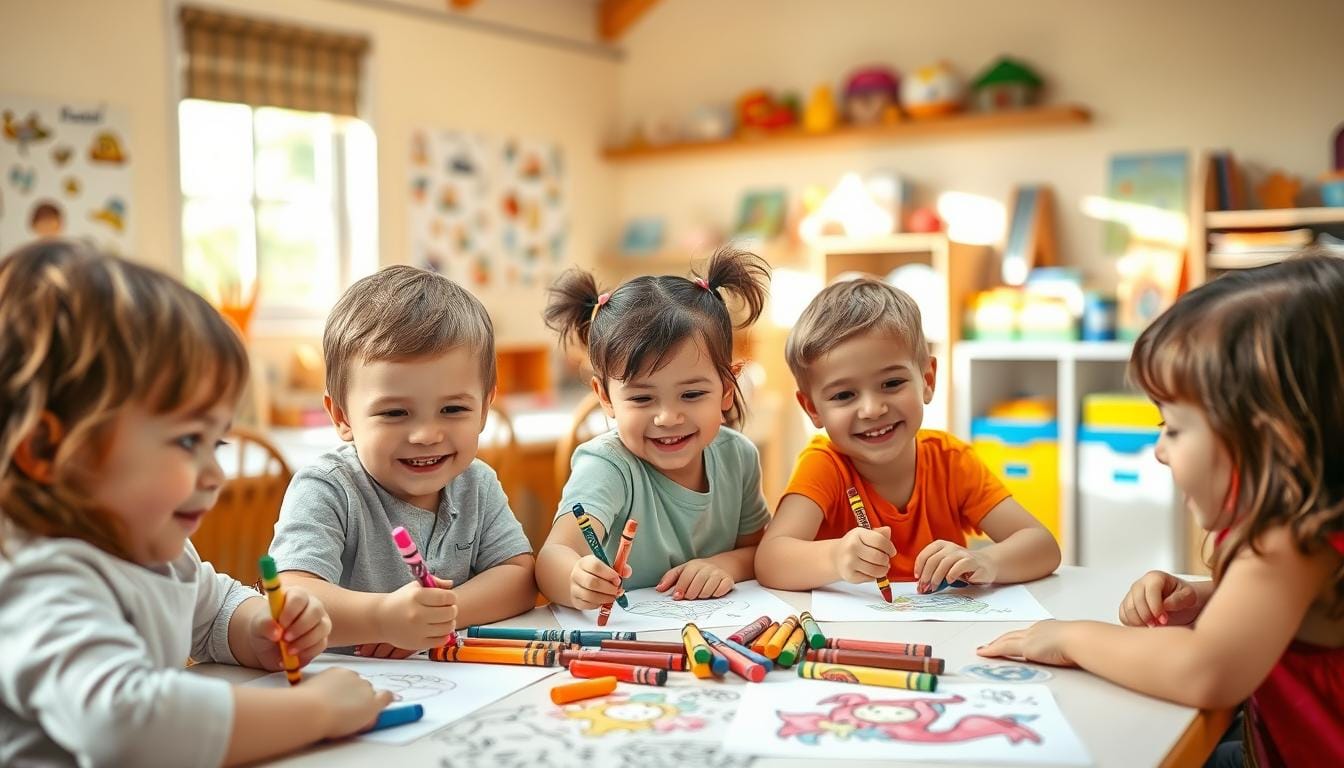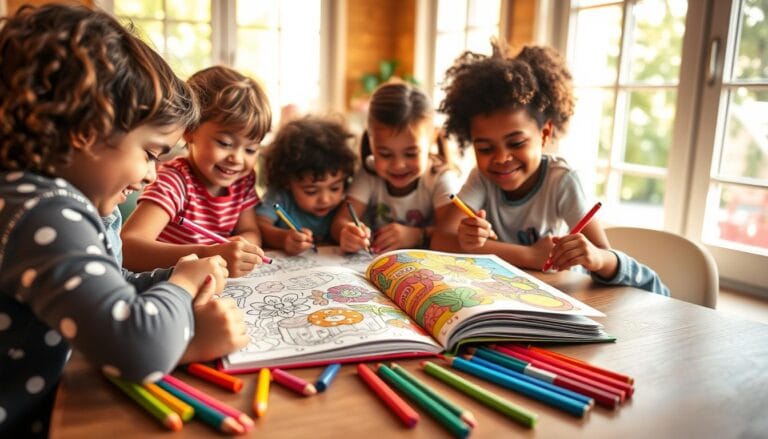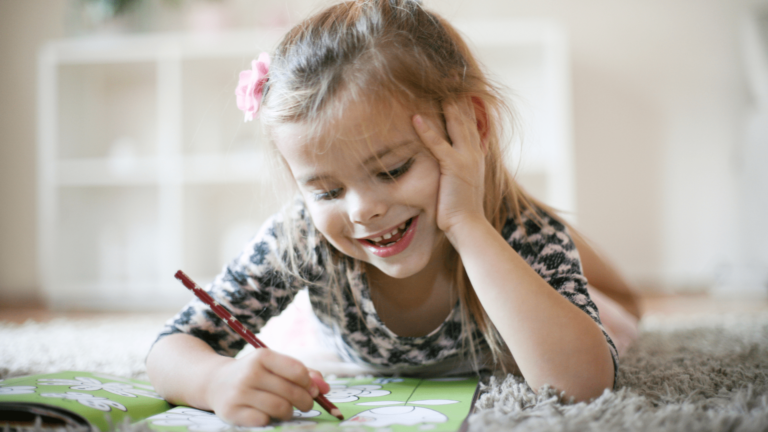Why Coloring Is More Than Just Fun for Children
As a parent or caregiver, you might often find yourself wondering what value lies in the simple act of coloring. Is it just a way to keep children occupied, or is there something more to it? The truth is, coloring is a multifaceted activity that offers a range of benefits for kids.
Coloring helps develop fine motor skills, hand-eye coordination, and creativity in children. It’s an activity that not only fosters self-expression but also lays the groundwork for future academic skills.
Key Takeaways
- Coloring enhances fine motor skills and hand-eye coordination.
- It fosters creativity and self-expression in children.
- Coloring activities can improve cognitive skills.
- It’s a valuable tool for developing problem-solving abilities.
- Coloring can be a calming and focusing activity for kids.
The Overlooked Power of Coloring Activities
Coloring is more than just a fun activity. It shapes young minds in powerful ways. When kids color, they’re not just making art. They’re learning skills that last a lifetime.
From Simple Play to Developmental Tool
Coloring starts as a simple play but grows into a tool for development. It boosts fine motor skills, sparks creativity, and introduces colors and patterns.
The Science Behind Coloring and Brain Development
Studies show coloring impacts brain growth. It activates creative parts of the brain, boosting thinking and problem-solving abilities.
Modern Research Findings on Coloring Benefits
Recent studies highlight coloring’s cognitive perks. It improves focus and grades. It also eases stress and anxiety.
Historical Perspective on Children’s Coloring
Coloring has been a staple in kids’ lives for years. It’s evolved from basic drawing to a complex educational tool.
Evolution of Coloring as an Educational Activity
Coloring now plays a key role in learning. It teaches colors, shapes, and patterns in schools.
Cultural Significance of Coloring Across Societies
Cultures worldwide value coloring, using traditional designs and methods. It’s a meaningful activity across cultures.
| Aspect | Description | Benefits |
|---|---|---|
| Cognitive Development | Enhances problem-solving skills and concentration | Better academic performance |
| Emotional Well-being | Reduces stress and anxiety | Promotes emotional stability |
| Fine Motor Skills | Refines hand-eye coordination and dexterity | Prepares for writing and other precise activities |
Cognitive Development Benefits of Coloring
Coloring helps kids grow in many ways. It boosts their ability to recognize things, understand space, and remember better. These skills are key for learning and growing.
Enhancing Recognition of Colors, Shapes, and Patterns
Coloring makes kids better at seeing colors, shapes, and patterns. This is important for making sense of what they see.
Color Theory Basics for Young Minds
Learning color theory through coloring is great for kids. They learn about primary and secondary colors, and how colors work together. This knowledge helps them in art and learning.
Pattern Recognition Through Repetitive Coloring
Doing the same coloring over and over helps kids spot patterns. This skill is important for solving problems and understanding complex ideas. It makes them think better.
Developing Spatial Awareness
Coloring also helps kids understand space better. It teaches them about the position of objects in the world.
Understanding Boundaries and Spaces
Coloring inside lines and seeing spaces between objects improves spatial awareness. This skill is important for doing things that need coordination and good vision.
Translating 3D Concepts to 2D Paper
Coloring lets kids turn 3D ideas into 2D pictures on paper. This skill is key for solving problems and grasping abstract ideas.
Improving Memory and Visual Processing
Coloring also boosts memory and how well kids process what they see. It helps them remember and understand visual information better.
Color Association and Memory Formation
Linking colors with things helps kids remember better. They remember colors and what they mean, which improves their memory.
Visual Discrimination Skills Development
Coloring helps kids tell different things apart visually. This skill is important for reading, writing, and other school tasks.
| Cognitive Skill | Coloring Activity | Benefit |
|---|---|---|
| Color Recognition | Coloring different objects | Understanding color theory basics |
| Spatial Awareness | Coloring within boundaries | Understanding boundaries and spaces |
| Memory and Visual Processing | Repetitive coloring and pattern recognition | Improving memory and visual discrimination skills |
Fine Motor Skills Enhancement Through Coloring
Coloring is more than just a fun activity. It’s key for improving fine motor skills in kids. When you color with your child, you help them get better at tasks that need precision and coordination.
Hand-Eye Coordination Development
Coloring helps a lot with hand-eye coordination. Kids learn to match their hand movements with what they see. This makes them better at tasks that need precision.
Precision Control with Different Coloring Tools
Using different coloring tools like crayons, markers, and colored pencils is great. Each tool needs a special grip and technique. This helps kids improve their fine motor skills.
Progressive Skill Building from Scribbling to Detailed Work
As kids move from scribbling to detailed coloring, their fine motor skills get a lot better. This growth is key for mastering more complex tasks, like writing.
Strengthening Hand and Finger Muscles
Coloring also makes hand and finger muscles stronger. This is important for gripping and handling objects.
Preparing for Handwriting Through Coloring
The skills gained from coloring are vital for handwriting. By practicing coloring, kids build the strength and coordination needed for writing.
Grip Development and Pencil Control
Coloring helps kids develop the right grip and control over pencils. This is the foundation for good handwriting.
Why Coloring Is More Than Just Fun for Children: A Psychological Perspective
Coloring is more than just a fun activity for kids. It’s a tool that helps them express their creativity and shows how they’re feeling. It’s a way to understand their emotional and psychological health.
Self-Expression and Communication
Coloring lets kids share their feelings without words. They use colors and art to show what they’re thinking and feeling.
Expressing Feelings Through Color Choices
Kids pick colors to show their emotions. For example, red might mean anger, and blue might mean sadness.
Non-Verbal Communication Through Art
Art can reveal a lot about a child’s feelings. It gives parents and caregivers a peek into their emotional world.
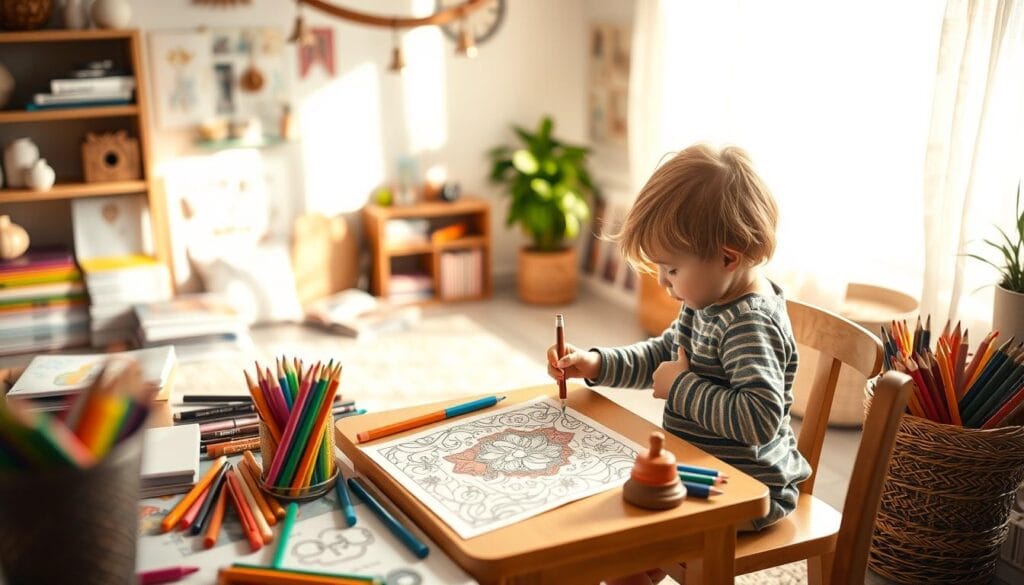
Building Confidence and Self-Esteem
Finishing a coloring project makes kids feel proud. It boosts their confidence and self-esteem.
Accomplishment and Pride in Completed Work
When kids finish coloring, they feel proud of what they’ve made. This pride helps them feel better about themselves and encourages them to try new things.
Overcoming Challenges and Perseverance
Coloring helps kids learn to keep going, even when it’s hard. They work to finish a design or solve problems in their art.
| Benefits of Coloring | Description |
|---|---|
| Self-Expression | Children express their feelings through color and art. |
| Confidence Building | Completing coloring activities boosts self-esteem. |
| Emotional Processing | Coloring helps children work through their emotions safely. |
Processing Emotions Through Art
Coloring is a safe way for kids to deal with their feelings. They use colors and art to show and manage their emotions.
Color as an Emotional Outlet
Colors can be a way for kids to release their feelings. It’s a healthy way for them to express and manage their emotions.
Working Through Difficult Feelings Safely
Coloring helps kids deal with tough emotions in a safe space. It helps them learn to control their feelings better.
“Art therapy, including coloring, has been shown to have a positive impact on children’s emotional well-being, providing a healthy outlet for their feelings and concerns.”
Educational Advantages of Regular Coloring Practice
Coloring regularly is great for kids. It helps them grow in many ways. Kids learn important skills that help them do well in school.
Pre-Writing Skill Development
Coloring is key for kids to get better at writing. It improves their hand-eye coordination and fine motor skills. These skills are needed for writing.
From Coloring to Letter Formation
Coloring helps kids learn to write letters. It teaches them to control their movements. This is the first step to writing letters and words.
Building Writing Stamina Through Coloring
Coloring builds stamina for writing. Kids learn to focus and stay on task. This is important for writing.
Introduction to Basic Concepts
Coloring books introduce kids to numbers, letters, and themes. They make learning fun and engaging.
Learning Numbers, Letters, and Themes Through Coloring Pages
Coloring pages teach specific subjects. Kids learn about animals, seasons, or holidays while coloring.
Subject Integration in Educational Coloring Books
Educational coloring books cover many subjects. They offer a well-rounded learning experience. Kids see how different subjects are connected.
Following Instructions and Boundaries
Coloring teaches kids to follow rules and stay within boundaries. These skills are important for school and life.
Understanding Rules and Guidelines
Coloring teaches kids to follow rules, like staying within lines. This skill is crucial for completing tasks and reaching goals.
Developing Attention to Detail
Coloring requires kids to pay attention to detail. They learn to be meticulous and careful. This skill is important in many areas of life.
Coloring as Therapy: Emotional Regulation and Stress Relief
Coloring is a powerful tool for kids, helping them manage their feelings and learn to cope. It offers many benefits that improve their emotional health.
Creating a Calming Routine
It’s key for kids to have a calming routine. Coloring is a great part of this, offering a calming activity that helps them unwind.
Establishing Healthy Coping Mechanisms
Coloring lets kids find healthy ways to deal with their feelings. It gives them a positive way to express themselves.
Transitional Activities Using Coloring
Coloring can help kids transition between tasks. It reduces their anxiety and stress, making it easier for them to move on.
Managing Anxiety and Frustration
Coloring is a great way for kids to handle anxiety and frustration. It lets them channel their negative feelings into something creative.
Coloring for Children with Special Needs
For kids with special needs, coloring is especially helpful. It offers a personalized way to manage their emotions and find relief from stress.
Redirecting Negative Energy Positively
Coloring turns negative energy into something positive and creative. This boosts their emotional health.
Mindfulness Through Coloring
Coloring teaches kids to be mindful. It helps them stay in the moment, leading to better emotional control and less stress.
Present-Moment Awareness While Coloring
While coloring, kids learn to be present. This skill is vital for managing their emotions and reducing anxiety.
Focus and Concentration Benefits
Coloring improves focus and concentration. These skills help kids regulate their emotions and feel better overall.
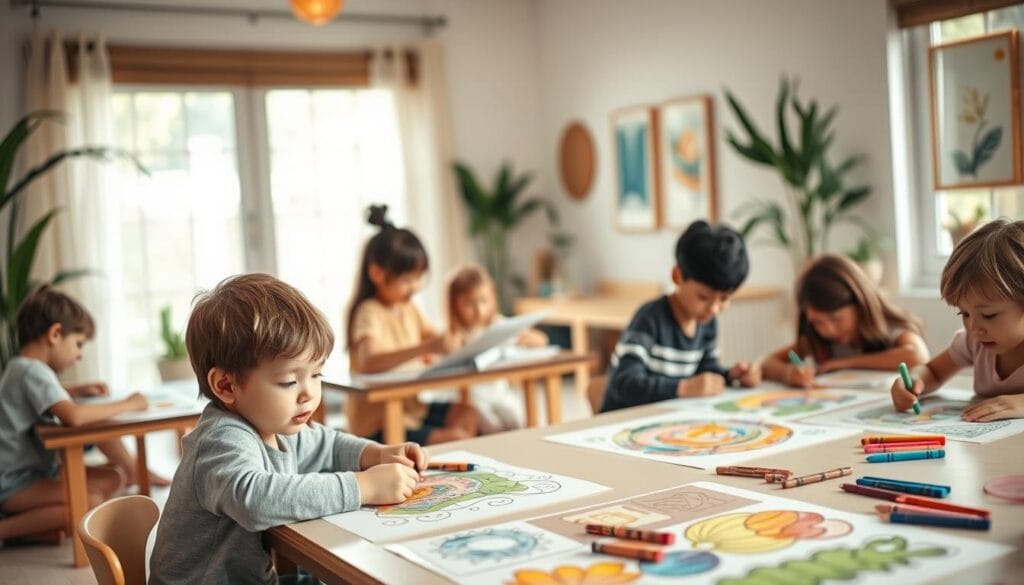
Social Benefits of Coloring Activities
Coloring activities are great for kids’ social growth. They boost creativity and teach important social skills.
Collaborative Coloring Projects
Working on coloring projects together helps kids learn to work as a team. They practice cooperation and clear communication.
Group Murals and Shared Creations
Group murals and shared coloring projects teach kids to work together. They share ideas and take on tasks, building teamwork and community spirit.
Learning Cooperation Through Art
Coloring together teaches kids the importance of teamwork. They see how together, they can make something amazing.
Sharing and Discussing Artwork
Sharing and talking about their art is key. It helps kids improve their communication and learn to value others’ creativity.
Developing Communication Skills Through Art Talks
Talking about their art helps kids get better at speaking. They learn to explain their work and get feedback.
Building Respect for Others’ Creative Expressions
By sharing and discussing their art, kids learn to respect others’ creativity. They see different styles and learn to be inclusive and supportive.
| Social Benefit | Description | Outcome |
|---|---|---|
| Collaborative Projects | Working together on coloring projects | Enhanced teamwork and cooperation |
| Sharing Artwork | Discussing and sharing colored creations | Improved communication skills and respect for others |
Creative Expression and Imagination Development
Coloring lets kids show their thoughts, feelings, and dreams. It helps them grow their creative skills. These skills are key for solving problems and expressing themselves.
Beyond the Lines: Encouraging Creative Freedom
Letting kids color outside the lines boosts their creative freedom. This freedom lets them try new colors, patterns, and ways of coloring. It sparks their imagination and creativity.
When to Use Structured vs. Free-Form Coloring
Structured coloring, like coloring books, helps kids with fine motor skills and learning boundaries. Free-form coloring lets kids express themselves freely, boosting creativity and imagination. Mixing both can be good.
Combining Techniques for Maximum Benefit
Mixing structured and free-form coloring gives kids a full creative experience. Starting with a structured activity and then free-form coloring helps them smoothly explore their creativity.
Storytelling Through Coloring
Coloring is great for telling stories. Kids can make up stories with their colored pictures. This improves their language skills and imagination. It also lets them express their thoughts and feelings.
Creating Narratives Around Colored Images
By making stories from their colored pictures, kids work on their storytelling skills. This connects their artwork to a bigger story. It boosts their thinking and emotional growth.
Sequential Art and Basic Comic Creation
Sequential art and making comics involve arranging colored pictures in a story order. This activity boosts creativity, imagination, and storytelling. It also introduces sequencing and narrative flow to kids.
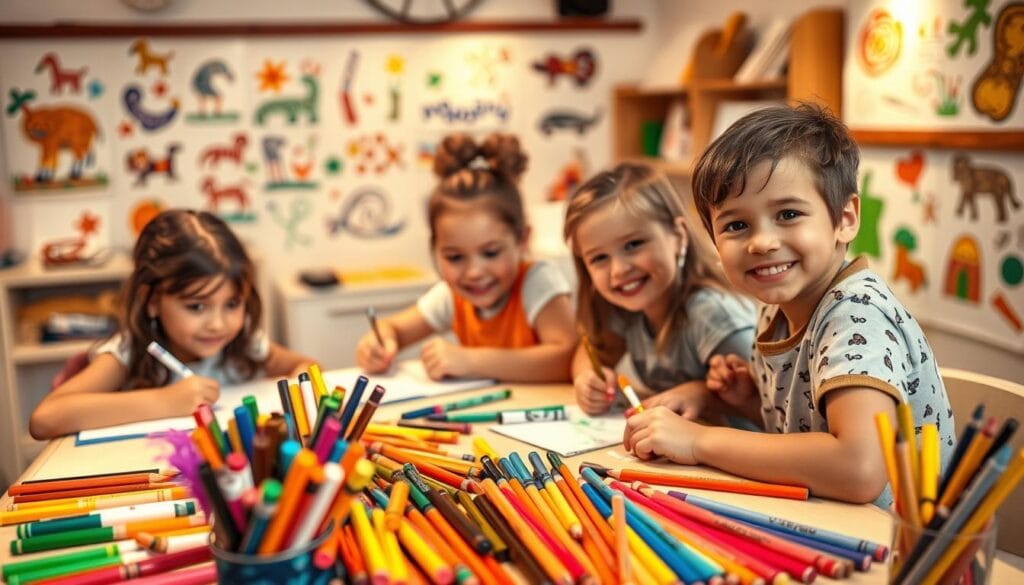
| Activity | Benefits | Age Group |
|---|---|---|
| Structured Coloring | Develops fine motor skills, teaches boundaries | 3-5 years |
| Free-Form Coloring | Promotes creativity, imagination | 4-6 years |
| Storytelling Through Coloring | Enhances narrative skills, cognitive development | 5-7 years |
Practical Tips for Maximizing Coloring Benefits
To get the most out of coloring, think carefully about what you provide and where you color. The right materials and a good environment can make a big difference. This helps your child enjoy coloring more.
Age-Appropriate Coloring Materials
Choosing the right coloring tools is key for your child’s growth. Make sure the tools match your child’s age and skill level.
Best Tools for Different Developmental Stages
Young kids do best with washable crayons and big, easy-to-hold markers. As they get older, they can use colored pencils and finer markers.
Safety Considerations for Young Artists
Always pick safe, non-toxic materials for your child. Make sure they are strong and won’t break easily or be a choking hazard.
Creating an Inspiring Coloring Environment
The place where your child colors can really boost their creativity and fun. A neat and inspiring space can help them love art more.
Setting Up a Dedicated Art Space
Make a special area for coloring. It should be bright and comfy. This could be a corner of their room or a part of the kitchen table.
Organizing Supplies for Independence
Keep coloring stuff organized and easy for your child to get. This lets them be independent and try out different things.
Balancing Structure and Freedom
It’s important to guide your child but also let them be free to express themselves. Finding the right balance is key.
When to Guide and When to Step Back
Help with using materials and techniques, but also let your child explore on their own. This helps them learn and grow.
Encouraging Healthy Risk-Taking in Art
Encourage your child to try new things and see mistakes as chances to learn. This boosts their creativity and confidence.
| Age Group | Recommended Materials | Tips for Parents |
|---|---|---|
| 2-3 Years | Washable crayons, large markers | Supervise closely, encourage exploration |
| 4-5 Years | Colored pencils, coloring books | Introduce basic color theory, encourage staying within lines |
| 6+ Years | Variety of markers, colored pencils, sketchbooks | Encourage complex projects, discuss art techniques |
“The creative adult is the child who has survived.”
By following these tips, you can make coloring a great experience for your child. It will help them grow and appreciate art for life.
Conclusion: Embracing Coloring as a Valuable Developmental Activity
Coloring is more than just a fun activity for kids. It plays a big role in their growth. Knowing how coloring helps kids can guide you in adding it to their daily life.
Coloring has many benefits for kids. It boosts their spatial awareness and hand-eye coordination. It also helps them feel more confident in their creativity. Plus, it’s a way for kids to express their feelings and handle stress.
By embracing coloring, you can help your child learn and grow in a fun way. Whether it’s through structured coloring books or free creative play, it’s a powerful tool. Encourage your child to explore coloring and watch them flourish.
